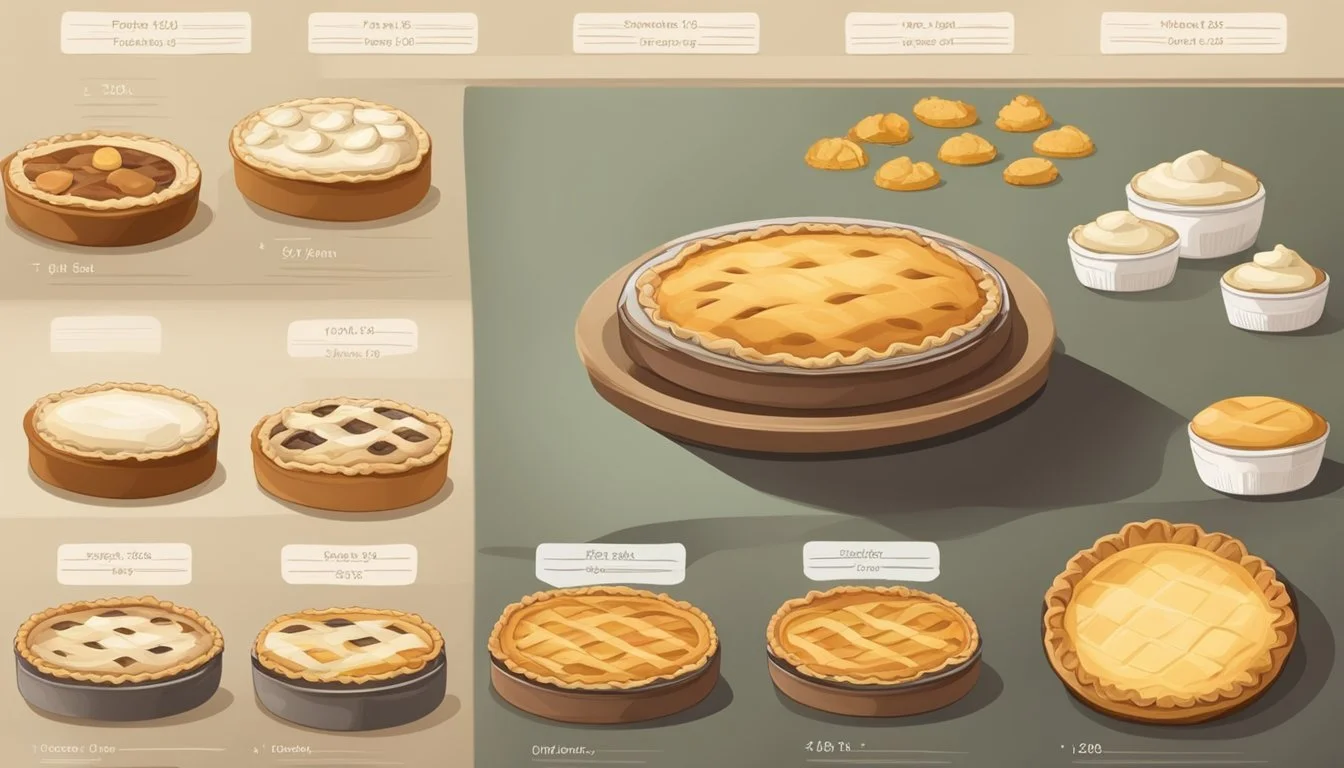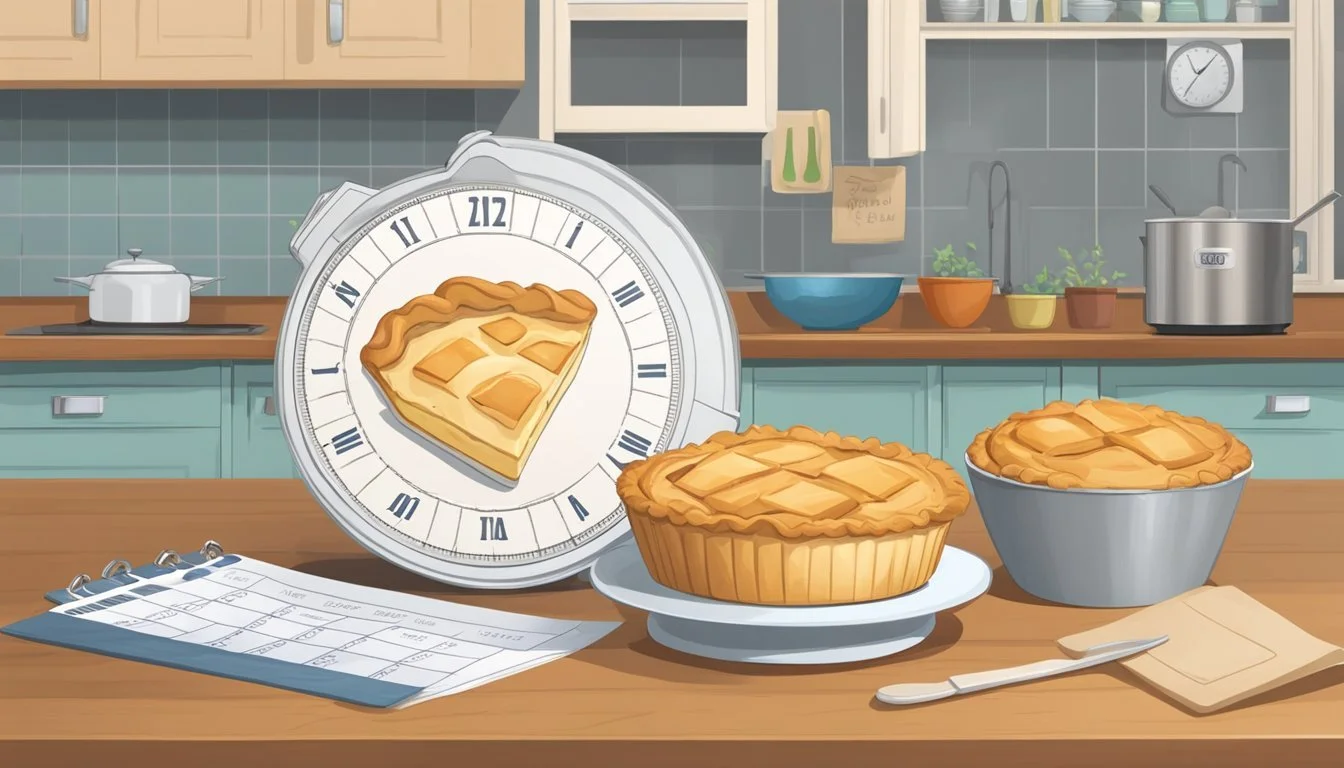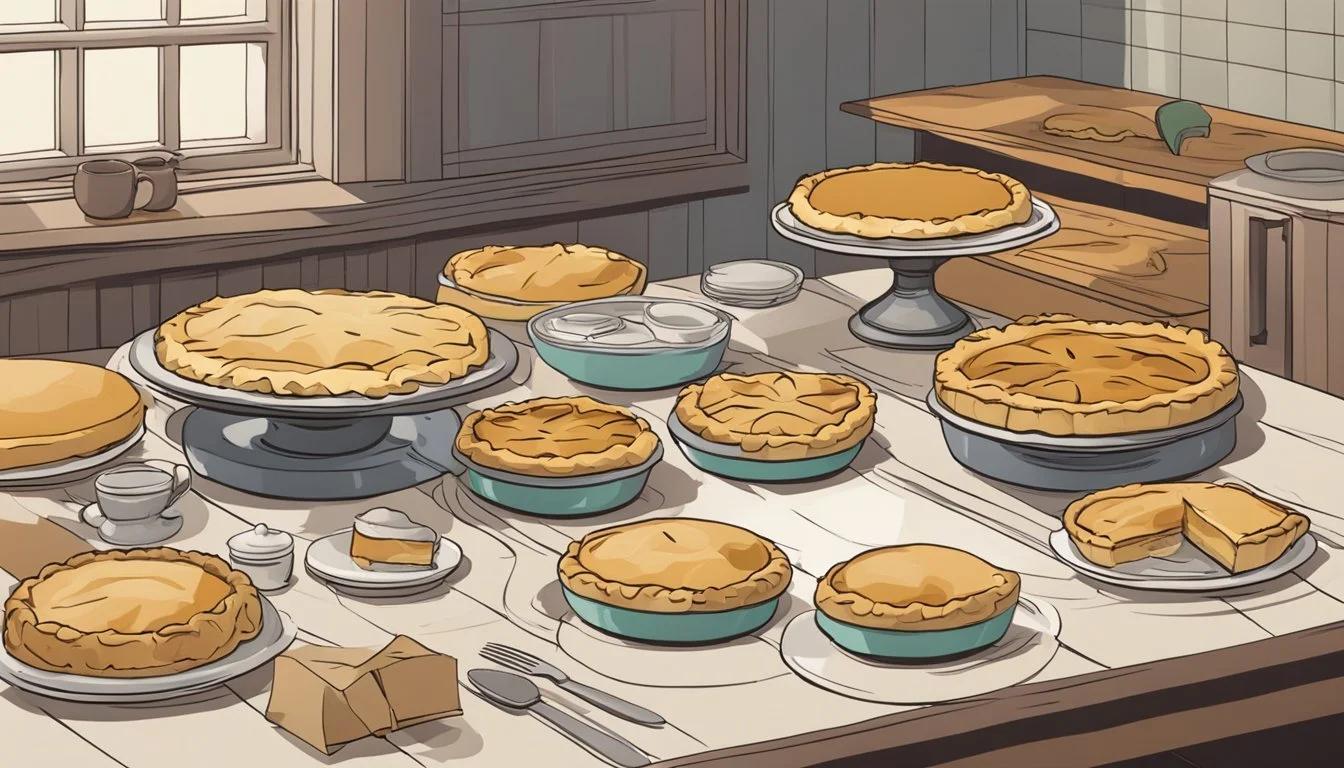How Long Do Pies Last?
Shelf Life and Storage Tips
When it comes to the shelf life of pies, there are several factors to consider, such as the type of pie, the ingredients used, and how the pie is stored. Pies come in many varieties, including fruit pies, cream pies, and custard pies, each with a different longevity due to their ingredients. Proper storage is essential to maintain the flavor and safety of the pie for consumption.
Fruit pies, which are often acid-based and contain sugar, can last at room temperature for up to two days; after that, they can be refrigerated for an additional two days to maintain their quality. On the other hand, pies that contain egg or dairy, such as pumpkin, custard, and cream pies, should be stored in the refrigerator right away and will keep for up to four days. The risk of bacterial growth is higher with these pies due to the perishable ingredients they contain.
To achieve the best results, pies should be covered properly. Wrapping the pie tightly in plastic wrap or aluminum foil can help maintain its freshness and prevent it from absorbing other flavors in the fridge. If the pie is to be kept for a longer period, freezing is an option, extending its life for up to several months, depending on the type of pie. However, it is important to cool the pie completely before freezing to prevent the buildup of ice crystals and freezer burn.
Pie Fundamentals
When considering the shelf life of pies, it is essential to understand that different types of pies and their ingredients have a significant impact on how long they can be safely enjoyed.
Types of Pie
Fruit pies, such as apple or cherry, generally contain a high amount of sugar and acidity which can act as preservatives. These pies typically last at room temperature for a day or two and can be extended to a few days longer when refrigerated. In contrast, pumpkin pies, pecan pies, custard pies, and chiffon pies are rich in dairy and eggs, therefore requiring refrigeration and having a shorter shelf life of about four days. Savory pies containing meat and vegetables must also be refrigerated and consumed within a few days to maintain freshness and prevent spoilage.
Ingredients Impact on Longevity
The shelf life of a pie is largely determined by the moisture content and the types of ingredients used. Ingredients like meat, dairy, and eggs are perishable and require refrigeration, reducing the pie's shelf life. Sugar, while acting as a preservative in fruit pies, is less effective in pies with high moisture content. The presence of moisture can lead to a faster deterioration as it creates an environment conducive to microbial growth. Ingredients like spices do not significantly extend shelf life but can affect the pie's flavor profile over time.
Baking and Preparation
When baking pies, consistent techniques are essential for ensuring proper texture and taste, while preparing pies in advance can be advantageous for both home bakers and professionals.
Baking Techniques
The choice of oven temperature and timing are pivotal in achieving the desired texture and flavor in a pie. Pie crusts, whether they are made of pastry crust, cookie crust, or pie dough, require a specific approach when baking. For a flaky pastry crust, bakers must ensure the oven is preheated properly and often bake at high temperatures initially to set the structure quickly. Rolling the dough to an even thickness and chilling it before baking can help prevent shrinking and maintain shape during the baking process.
Preparing Pies In Advance
Bakers can prepare pies in advance to manage their time effectively. Pie dough can be made ahead and stored in the refrigerator for two to three days, or it can be frozen for longer storage. When a baker needs to advance their preparation, they can also pre-bake or 'blind bake' pie crusts. This technique involves baking the crust partially or fully before adding the filling, which is especially helpful for pies with a wet filling that might make a raw crust soggy.
Storage Fundamentals
Proper storage is crucial for maintaining the freshness and flavor of pies. The shelf life can be greatly impacted by the method of storage, which includes room temperature, refrigeration, and freezing. Each approach caters to different pie types and desired longevity.
Room Temperature Storage
Fruit pies, such as apple, can typically be stored at room temperature for up to two days. When storing pies on the counter, it's essential to cover them with plastic wrap or aluminum foil to protect against contaminants and prevent drying out.
Coverage: Wrap pies in plastic wrap or aluminum foil.
Duration: Store for up to 2 days.
Refrigeration
Pies containing dairy, eggs, or custard should be refrigerated in an airtight container or wrapped securely in foil or plastic wrap. The refrigerator extends a pie's freshness, usually allowing for a shelf life of 3 to 4 days.
Coverage: Use an airtight container, plastic wrap, or aluminum foil.
Duration: Keeps fresh for 3 to 4 days.
Freezing Pies
For long-term storage, pies can be frozen. First, allow the pie to cool completely, then wrap it in plastic wrap or aluminum foil and place in a storage container to prevent freezer burn. Fruit pies freeze well and can be kept in the freezer for up to 6 months. Avoid freezing custard-based pies as their texture can be adversely affected.
Process: Cool, wrap, and place in a storage container.
Duration: Fruit pies last up to 6 months in the freezer.
Preserving Pie Quality
Proper techniques are paramount in extending a pie's life without sacrificing its quality. Attention to detail can prevent common issues like freezer burn and texture changes.
Protecting Against Freezer Burn
To protect pies from freezer burn — a condition caused by moisture loss resulting in dried out and flavorless patches — one should wrap the pie thoroughly. Whether it's a baked fruit pie or an unbaked dough, the key is to eliminate air exposure.
Steps for Prevention:
Cool the baked pie completely to avoid condensation.
Wrap the pie tightly in plastic freezer wrap or aluminum foil.
For added protection, place the wrapped pie in a heavy-duty freezer bag or an airtight container.
Maintaining Texture and Flavor
Preserving the texture and flavor of a pie involves managing moisture and temperature. Fruit pies, for instance, have delicate, flaky layers that can become soggy if not stored correctly.
For unbaked dough:
Store in an airtight container or tightly wrapped in the fridge.
Use within 2-3 days to maintain its pliability and prevent drying out.
For baked pies:
Store at room temperature for the first two days.
If longer storage is needed, refrigerate with a loose cover of aluminum foil or plastic wrap for up to two additional days to balance moisture retention and texture.
By following these guidelines, the integrity of both the crust and filling can be preserved, ensuring that the pie remains as close to its intended taste and texture as possible.
Food Safety Considerations
When considering the longevity of pies, food safety is paramount. Preserving the quality and preventing foodborne illness hinges on understanding how spoilage occurs and following established guidelines for storage.
Understanding Food Spoilage
Spoilage in food is primarily caused by the growth of bacteria, which can occur rapidly at temperatures between 40°F and 140°F. Pies, especially those containing eggs, dairy, or meat, provide an ideal environment for these bacteria. The visual and olfactory cues can signal when a pie has spoiled, such as an off odor, a change in color, or the presence of mold. It is crucial for one's health to recognize these signs to prevent the risk of foodborne illness.
Guidelines from Authorities
The U.S. Department of Agriculture (USDA) and the Food and Drug Administration (FDA) provide guidelines to ensure food safety. They recommend:
Refrigerating pies promptly after baking.
Consuming custard and chiffon pies within 3 to 4 days.
Wrapping pies tightly in plastic wrap for extended fridge storage.
Not freezing pies that contain egg or dairy to avoid texture and quality degradation.
Pie Type Refrigerator Storage Freezer Storage Custard and Chiffon 3 to 4 days Not recommended Fruit and Berry 1 to 5 days 2 to 4 months Meat-based Pies 3 to 4 days 1 to 3 months Pumpkin and Pecan 3 to 4 days 1 to 2 months
Note: The listed storage times in the table are meant for ensuring quality and safety as recommended by food safety authorities.
Serving and Consumption
When serving pie, one must consider the type of pie to ensure appropriate thawing and reheating methods are used, as well as following best practices to enjoy leftovers safely. Different kinds of pies, from fruit-filled to custard-based, have specific serving recommendations to preserve taste and texture.
Thawing and Reheating
Before serving, pies that have been refrigerated, such as custard pies or mousse pies, should be brought to room temperature for optimal flavor. Pies with a fruit filling like apple pie can be reheated to enhance their taste. To reheat a refrigerated fruit pie:
Place it in a 350°F oven for about 15 minutes.
If pies have been frozen, proper thawing is crucial, especially for delicate ones such as chiffon or coconut cream pie. Thaw them gradually by transferring from the freezer to the fridge a day before serving.
For those in a hurry, a microwave can be used to thaw slices of pie. However, microwaving can affect the texture of the crust and is not recommended for pies with a creamy or custard filling.
Best Practices for Leftovers
Leftover pie is a common occurrence, especially after a large meal with family and friends, or during Thanksgiving when Thanksgiving pies are plentiful. To maximize the shelf-life of leftover pies:
Store fruit-filled pies at room temperature for up to two days; refrigerate afterwards to extend their freshness for an additional two days.
Refrigerate pecan pies, custard pies, and mousse pies immediately, and consume within four days.
Custard and cream pies should not be frozen, but other types like fruit pies can be frozen for a longer shelf life.
Use an airtight container or wrap in aluminum foil or plastic wrap to prevent drying out.
Always chill leftover pie in the kitchen to ensure safety and maintain quality. Following these guidelines will let a family enjoy leftover pie for up to 10 days, depending on the type and storage. When in doubt, a chef or baking professional can give advice on best practices for pie storage and consumption.








